For millennia‚ nature has served as a source of inspiration for artists‚ poets‚ and thinkers․ Yet‚ beyond its aesthetic and philosophical influence‚ nature holds a treasure trove of ingenious designs and efficient processes․ Biomimicry‚ a relatively new field of study‚ delves into this very treasure trove‚ seeking to emulate natures time-tested solutions to solve human challenges․
Understanding Biomimicry
Biomimicry‚ at its core‚ is innovation inspired by nature․ Its the conscious effort to learn from and mimic the structures‚ functions‚ and ecosystems of the natural world to create more sustainable and efficient designs․ Unlike simply using natural materials‚ biomimicry delves deeper‚ seeking to understand the underlying principles that govern natures creations․
Key Principles of Biomimicry:
- Nature as Model: Biomimicry views nature as a mentor‚ recognizing the 3․8 billion years of evolution that have resulted in highly optimized and sustainable solutions․
- Form Follows Function: In nature‚ form and function are inextricably linked․ Biomimicry seeks to understand this relationship to develop designs that are both aesthetically pleasing and highly functional․
- Life-Friendly Chemistry: Natural processes often rely on elegant and non-toxic chemical reactions․ Biomimicry aims to emulate these processes‚ minimizing the use of harmful substances․
- Optimization and Efficiency: Nature tends towards efficiency‚ optimizing resource use and minimizing waste․ Biomimicry adopts this principle‚ striving for sustainable and resource-efficient designs․

Biomimicry in Action: Inspiring Examples
The applications of biomimicry are vast and diverse‚ spanning across various fields and industries․ Here are some compelling examples:
1․ The Shinkansen Bullet Train: Inspired by the Kingfisher
The sleek nose of Japans high-speed Shinkansen bullet train is modeled after the beak of a kingfisher․ This design minimizes the sonic boom effect‚ allowing the train to achieve incredibly high speeds while remaining remarkably quiet․
2․ Wind Turbines: Mimicking Humpback Whale Fins
Humpback whales‚ despite their massive size‚ are surprisingly agile swimmers․ This agility is partly due to the unique bumpy edges on their fins‚ called tubercles․ Wind turbine manufacturers have incorporated this design‚ finding that the tubercles reduce drag and noise while increasing energy efficiency․
3․ Velcro: The Classic Example of Bio-Inspiration
Velcro‚ the ubiquitous fastener‚ was inspired by the humble burdock burr․ Swiss engineer George de Mestral‚ intrigued by the burrs tenacious grip‚ discovered the tiny hooks that allowed it to cling to fabric․ This led to the invention of the two-part hook-and-loop fastener system we know as Velcro․
4․ Self-Healing Materials: Learning from Living Tissues
Researchers are developing self-healing materials inspired by the remarkable ability of living tissues to repair themselves․ These materials‚ capable of autonomously mending minor cracks and damages‚ have the potential to revolutionize industries ranging from construction to aerospace․
The Future of Biomimicry
As we face increasingly complex challenges‚ from climate change to resource depletion‚ biomimicry offers a promising path forward․ By looking to nature for inspiration‚ we can potentially unlock a new era of sustainable and efficient technologies․
Emerging Trends in Biomimicry:
- Bio-inspired Robotics: Developing robots that mimic the movements and capabilities of animals‚ such as insect-like drones for precision agriculture or snake-like robots for search and rescue operations․
- Biomimicry in Architecture: Designing buildings that regulate temperature and ventilation naturally‚ drawing inspiration from termite mounds or self-shading plants․
- Biomimicry in Medicine: Developing new drugs and medical devices inspired by natural compounds and biological processes․
Conclusion: Embracing Natures Wisdom
Biomimicry is more than just copying nature; its a profound shift in perspective․ Its about recognizing the ingenuity inherent in the natural world and embracing nature as a source of inspiration and guidance․ As we delve deeper into the intricacies of the natural world‚ we can unlock a wealth of knowledge to create a more sustainable and harmonious future for humanity․
Expanding the Horizons of Innovation: The Future Potential of Biomimicry
Biomimicry stands poised to revolutionize not just individual products or processes‚ but entire industries․ As our understanding of biological systems deepens‚ so too does the potential of biomimicry to address some of humanitys most pressing challenges․ Let us delve further into the expanding horizons of this fascinating field:
1․ Biomimicry for a Circular Economy:
Nature operates in cycles‚ with waste from one process becoming nourishment for another․ This principle of a circular economy‚ where resources are used and reused with minimal waste‚ is central to biomimicry․ By emulating natural cycles‚ we can move away from the linear “take-make-dispose” model towards a more sustainable and regenerative system․ For instance‚ imagine packaging materials inspired by deciduous leaves‚ designed to decompose naturally‚ enriching the soil rather than polluting the environment․
2․ Biomimicry and Climate Change Mitigation:
Nature offers a wealth of solutions for carbon sequestration‚ energy efficiency‚ and climate resilience․ Biomimicry can play a pivotal role in mitigating climate change by:
- Developing carbon-negative materials inspired by how shells and coral reefs sequester carbon dioxide․
- Designing buildings with bio-inspired ventilation and insulation‚ reducing reliance on energy-intensive heating and cooling systems․
- Creating drought-resistant crops inspired by desert plants‚ enhancing food security in the face of changing climates․
3․ Biomimicry for Enhanced Human Wellbeing:
Beyond technological advancements‚ biomimicry can inspire solutions for improving human health and wellbeing․ This can take the form of:
- Developing prosthetic limbs with agility and responsiveness inspired by animal locomotion․
- Creating biocompatible materials for implants and regenerative medicine‚ mimicking the properties of natural tissues․
- Designing urban spaces that incorporate elements of nature‚ promoting mental and physical wellbeing․
4․ Advancing Biomimicry through Interdisciplinary Collaboration:
The true potential of biomimicry can be unlocked through collaborative efforts that transcend traditional disciplinary boundaries․ Biologists‚ engineers‚ architects‚ designers‚ and entrepreneurs must work together‚ sharing knowledge and expertise‚ to translate natures wisdom into practical and impactful solutions․
Conclusion: Towards a Bio-Inspired Future
Biomimicry is not simply about imitating nature; its about learning from its 3․8 billion years of research and development․ By embracing nature as a model‚ mentor‚ and measure‚ we can unlock a new era of innovation‚ creating a future where technology exists in harmony with the natural world․ As we face unprecedented challenges in the 21st century‚ biomimicry offers a beacon of hope‚ reminding us that the solutions we seek may already exist within the intricate and elegant designs of nature․
Scaling Biomimicry: From Niche Inspiration to Transformative Design Paradigm
While the examples cited thus far illustrate the profound potential of biomimicry‚ its widespread adoption necessitates a shift from isolated instances of inspiration to a fully integrated design philosophy․ This transition requires addressing several key challenges and opportunities:
1․ Standardizing Biomimicry Methodologies:
Currently‚ there exists a lack of standardized methodologies for applying biomimicry across different disciplines․ Developing robust frameworks and best practices will enable a more systematic and rigorous approach to bio-inspired design‚ ensuring replicability and scalability of solutions․
2․ Bridging the Knowledge Gap:
Effective biomimicry hinges on a deep understanding of both biological systems and engineering principles․ Fostering greater collaboration between biologists‚ engineers‚ material scientists‚ and designers is crucial․ This interdisciplinary approach can be facilitated through dedicated research centers‚ educational programs‚ and knowledge-sharing platforms․
3․ Leveraging Big Data and Computational Tools:
The rapidly expanding fields of bioinformatics and computational biology offer unprecedented access to biological data․ Harnessing this data through machine learning and artificial intelligence can accelerate the identification of relevant biological principles and their translation into design solutions․ Imagine a future where algorithms can sift through vast biological databases to propose optimal bio-inspired solutions for specific engineering challenges․
4․ Addressing Ethical Considerations:
As we delve deeper into emulating nature‚ ethical considerations become paramount․ It is crucial to engage in responsible biomimicry‚ ensuring that the sourcing of biological inspiration and the implementation of bio-inspired technologies are conducted ethically and sustainably․ This includes respecting intellectual property rights of indigenous communities who have long held knowledge of natures designs․
Biomimicry: A Catalyst for Sustainable Innovation
Biomimicry is not merely a technological tool but a profound philosophical shift․ It compels us to view nature not as a resource to be exploited‚ but as a source of knowledge and inspiration․ By embracing biomimicry‚ we embark on a path towards a future where human ingenuity works in concert with the natural world‚ leading to truly sustainable and elegant solutions for generations to come․

Biomimicry: A Paradigm Shift in Design and Innovation
Beyond its immediate applications‚ biomimicry represents a fundamental paradigm shift in how we approach design and innovation․ It challenges the anthropocentric view of human ingenuity as separate from and superior to nature‚ advocating instead for a more biocentric perspective that recognizes the inherent wisdom embedded in biological systems honed over billions of years of evolution․ This shift in perspective has profound implications for various fields:
1․ Transforming Educational Frameworks:
Integrating biomimicry into educational curricula‚ from elementary school to higher education‚ is crucial for nurturing a generation of professionals equipped to tackle complex challenges through a bio-inspired lens․ This involves:
- Developing interdisciplinary courses: Fostering collaboration between life sciences‚ engineering‚ design‚ and business schools to provide a holistic understanding of biomimicry principles and applications․
- Experiential learning opportunities: Engaging students in hands-on projects that challenge them to identify design problems and seek bio-inspired solutions through direct observation of nature․
- Promoting biomimicry research: Funding research initiatives that advance our understanding of biological systems and their potential for technological translation․
2․ Redefining Business Practices:
Biomimicry has the potential to disrupt traditional business models‚ fostering a transition towards a more circular and sustainable economy․ This can be achieved by:
- Life Cycle Assessment (LCA) integration: Incorporating biomimicry principles into LCA methodologies to evaluate the environmental impact of products and processes throughout their entire life cycle‚ from raw material extraction to disposal․
- Bio-inspired supply chain management: Emulating the interconnectedness and efficiency of natural ecosystems to create resilient and sustainable supply chains that minimize waste and optimize resource utilization․
- Promoting bio-based materials: Investing in research and development of materials inspired by nature‚ such as biopolymers and self-healing materials‚ to reduce reliance on synthetic and often environmentally damaging alternatives․
3․ Shaping Public Policy and Investment:
Governments and policymakers have a crucial role to play in mainstreaming biomimicry by:
- Incentivizing bio-inspired innovation: Providing tax breaks‚ grants‚ and other financial incentives to companies and research institutions developing biomimetic technologies and products․
- Implementing sustainable procurement policies: Prioritizing the purchase of products and services that incorporate biomimicry principles and demonstrate a lower environmental footprint․
- Raising public awareness: Launching public awareness campaigns to educate citizens about the benefits of biomimicry and its potential to address societal challenges․
Conclusion: Embracing Nature as a Guide for a Sustainable Future
Biomimicry is not a silver bullet solution‚ but rather a powerful framework for approaching design and innovation with a renewed sense of responsibility and awareness․ By embracing nature as a mentor and guide‚ we can unlock a wealth of knowledge and inspiration to create a future where technology and nature coexist in harmony․ As we navigate the complexities of the 21st century‚ biomimicry offers a compelling path towards a more sustainable‚ resilient‚ and equitable world for all․

Scaling Biomimicry: From Niche Inspiration to Mainstream Practice
While the allure of biomimicry is undeniable‚ its widespread adoption necessitates a transition from isolated examples of nature-inspired design to a systemic integration within various sectors․ This entails addressing key challenges and harnessing emerging opportunities to propel biomimicry from a niche source of inspiration to a mainstream design and innovation methodology․
1․ Overcoming Translational Barriers:
Translating natures elegance into practical‚ scalable‚ and commercially viable solutions often presents significant hurdles․ Bridging this gap requires:
- Standardized Metrics and Evaluation: Developing robust metrics to assess the effectiveness‚ sustainability‚ and scalability of biomimetic designs compared to conventional approaches is essential for informed decision-making and investment․
- Bio-Manufacturing Advancements: Emulating natures intricate fabrication processes often demands novel manufacturing techniques․ Further research into additive manufacturing‚ bio-printing‚ and self-assembly methods is crucial for realizing the full potential of bio-inspired designs․
- Cost-Effectiveness and Market Viability: Demonstrating the economic viability of biomimetic solutions‚ particularly in comparison to established technologies‚ is crucial for wider adoption․ This may involve lifecycle cost analyses highlighting long-term benefits such as reduced material use and increased energy efficiency․
2․ Embracing Digitalization and Data-Driven Design:
The convergence of biomimicry with rapidly evolving digital technologies‚ such as artificial intelligence (AI) and big data analytics‚ presents unprecedented opportunities to accelerate and enhance the design process․
- Bio-Inspired Algorithms and Generative Design: AI algorithms can be trained on vast biological datasets to identify optimal solutions for specific design challenges‚ mimicking natures evolutionary optimization processes․ This can lead to novel‚ high-performance designs not conceivable through traditional methods․
- Digital Twinning and Simulation: Creating virtual representations of bio-inspired designs allows for extensive testing and optimization within digital environments before physical prototyping․ This reduces development costs and accelerates the path to market․
- Open-Source Platforms and Collaboration: Facilitating knowledge sharing and collaboration among researchers‚ designers‚ and engineers through digital platforms can accelerate the dissemination of biomimicry principles and best practices․
3․ Expanding the Scope Beyond Technological Innovation:
While biomimicry has largely focused on technological applications‚ its principles hold immense potential for addressing broader societal and environmental challenges․
- Biomimicry for Social Innovation: Applying natures principles of cooperation‚ resilience‚ and resource efficiency to design social systems‚ organizations‚ and communities can foster greater sustainability and well-being․
- Biomimicry for Urban Planning and Architecture: Creating cities that function more like ecosystems‚ with integrated green infrastructure‚ energy-efficient buildings‚ and closed-loop systems‚ can mitigate environmental impacts and improve quality of life․
- Biomimicry for Conservation and Restoration: Understanding how natural systems have evolved to thrive can inform strategies for conservation‚ ecological restoration‚ and mitigating the effects of climate change․
Biomimicry: A Transformative Force for a Sustainable Future
As we navigate an era marked by unprecedented environmental and societal challenges‚ biomimicry emerges not as a mere design trend‚ but as a profound shift in our relationship with the natural world․ By embracing nature as a source of wisdom‚ inspiration‚ and innovation‚ we can chart a course towards a future where human ingenuity and ecological integrity are no longer at odds‚ but rather‚ interwoven strands of a sustainable and thriving planet․










